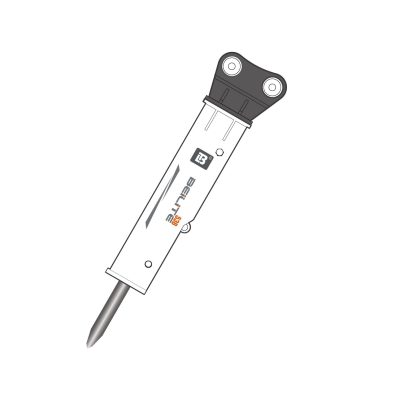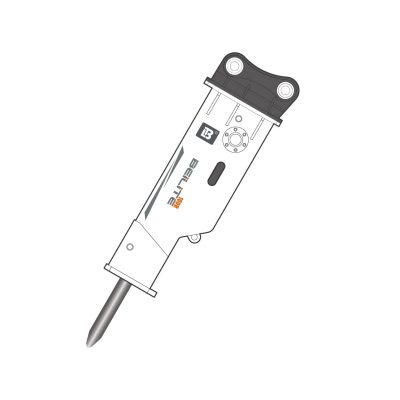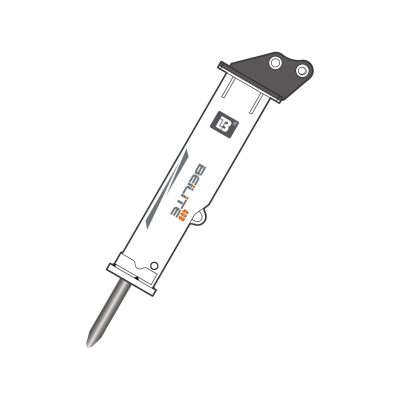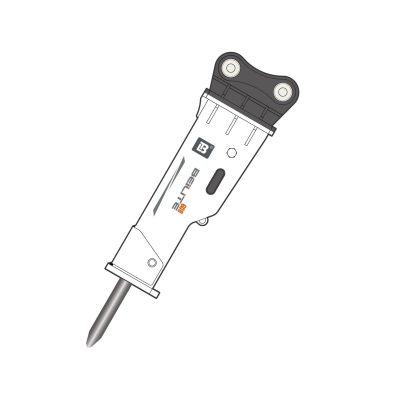Comment choisir un brise-roche hydraulique?
Choisir le bon brise-roche hydraulique garantit l'efficacité du travail et la sécurité de l'équipement. Les opérateurs et les entrepreneurs doivent évaluer les facteurs clés avant de choisir un brise-roche hydraulique adapté à leurs projets et à leurs machines.
Qu'est-ce qu'un brise-roche hydraulique ?
A brise-roche hydraulique utilise la pression hydraulique pour briser les roches, le béton et l'asphalte. Cet outil se fixe sur des porteurs tels que les excavateurs et les skid steers. Le choix d'un brise-roche hydraulique adapté au porteur et à la tâche augmente l'efficacité du travail et protège l'équipement.
Facteurs clés à prendre en compte lors du choix d'un brise-roche hydraulique
Compatibilité avec les opérateurs
Les opérateurs doivent s'assurer que compatibilité avec les marteaux hydrauliques avec le porteur. Chaque marteau hydraulique nécessite un débit d'huile et des niveaux de pression spécifiques. Les porteurs doivent répondre à ces exigences hydrauliques pour que le marteau fonctionne efficacement. Une mauvaise adaptation peut endommager à la fois le porteur et le marteau hydraulique.
Sélection du calibre du disjoncteur
Les utilisateurs doivent sélectionner la taille du brise-roche hydraulique en fonction du poids et de la capacité hydraulique du porteur. Les gros marteaux traitent des matériaux plus durs mais nécessitent des porteurs plus robustes. Les marteaux plus petits conviennent aux machines compactes et aux tâches plus légères. Un dimensionnement correct permet d'éviter les déformations de l'équipement et d'assurer la sécurité des opérations.
Conditions de travail et exigences en matière de candidature
Les gestionnaires de projet doivent évaluer les application du brise-roche hydraulique l'environnement. Pour les travaux à l'intérieur ou dans un espace restreint, les marteaux hydrauliques de petite taille offrent une meilleure maniabilité. Les travaux lourds à l'extérieur nécessitent des marteaux hydrauliques plus grands pour une puissance de rupture efficace.
Spécifications du brise-roche hydraulique
Les acheteurs doivent vérifier spécifications du brise-roche hydraulique comme la pression de travail, la plage de débit d'huile et le diamètre de l'outil. Des spécifications correctes garantissent un fonctionnement sans heurts. Une bonne adéquation permet d'éviter les pannes d'équipement et de minimiser les temps d'arrêt.
Énergie d'impact et coups par minute
Le performance du brise-roche hydraulique dépend de l'énergie d'impact et du nombre de coups par minute. Une énergie d'impact plus élevée donne des coups plus forts pour les matériaux durs. Les coups par minute indiquent la vitesse de frappe. Le choix du bon équilibre maximise la productivité et s'adapte à la tâche spécifique.
Types de brise-roche hydrauliques et leurs applications
Les opérateurs peuvent choisir entre deux options principales brise-roche hydraulique types : service léger et service lourd. Les brise-roche légers s'adaptent aux petits porteurs et fonctionnent bien dans les zones confinées. Les brise-roche à usage intensif s'attaquent aux gros rochers et aux structures en béton. Le choix du bon type de marteau garantit l'efficacité du projet et la sécurité de l'équipement.
L'influence de la taille du porteur sur le choix du brise-roche hydraulique
La taille du transporteur a un impact direct sur la compatibilité avec les marteaux hydrauliques. Les chariots doivent fournir un débit d'huile et une pression hydraulique corrects. L'utilisation d'un support sous-dimensionné ou surdimensionné entraîne un fonctionnement inefficace et risque d'endommager l'équipement. L'adaptation de la taille de l'entraîneur à celle du brise-roche garantit des performances fiables.
Évaluation de l'environnement de travail et de la dureté des matériaux
Les opérateurs doivent évaluer la dureté du matériau et les restrictions environnementales avant de choisir un brise-roche hydraulique. Les matériaux plus tendres comme l'asphalte nécessitent une énergie d'impact plus faible. Les roches dures nécessitent des brise-roches à plus forte énergie. La compréhension de ces facteurs aide les opérateurs à sélectionner le brise-roche approprié pour obtenir des résultats optimaux.
Comprendre les performances des brise-roche hydrauliques
Les équipes de travail doivent mesurer performance du brise-roche hydraulique sur la base de l'énergie d'impact, du nombre de coups par minute et de la pression de fonctionnement. Les disjoncteurs efficaces maintiennent des performances stables sans surcharger le porteur. Les équipes doivent vérifier ces paramètres pour garantir un fonctionnement sûr et efficace sur tous les projets.
Importance d'un bon entretien des marteaux hydrauliques
Les opérateurs doivent respecter des règles strictes entretien du brise-roche hydraulique les horaires. L'inspection régulière des bagues, de l'usure du burin et des conduites hydrauliques prolonge la durée de vie de l'équipement. Une lubrification appropriée et le remplacement des pièces en temps voulu évitent les dommages et garantissent des performances constantes du marteau.
Comment adapter les outils de brise-roche hydraulique à des tâches spécifiques
Différents outils de brise-roche hydraulique correspondent à des tâches spécifiques. Les pointes d'épines brisent les roches dures. Les burins coupent le béton armé. Les outils émoussés traitent les grandes masses de béton. Les opérateurs doivent choisir le bon outil pour s'adapter à la tâche et maximiser l'efficacité.
Erreurs courantes dans le choix d'un brise-roche hydraulique
De nombreux utilisateurs ignorent spécifications du brise-roche hydraulique et la compatibilité avec les porteurs. D'autres sélectionnent les marteaux uniquement en fonction de leur taille, sans tenir compte du débit et de la pression de l'huile. En évitant ces erreurs, on protège à la fois le brise-roche hydraulique et le transporteur contre les dommages.
Pourquoi les marteaux hydrauliques Beilite sont des choix fiables
Beilite propose une gamme complète de brise-roche hydrauliques pour s'adapter aux différents porteurs et applications. Chaque brise-roche Beilite est soumis à des contrôles de qualité stricts. Beilite fournit une assistance technique pour aider les clients à sélectionner le brise-roche hydraulique adapté à leurs besoins.
Résumé des principales considérations
Les opérateurs doivent évaluer compatibilité avec les marteaux hydrauliquesLe choix d'un brise-roche approprié garantit l'efficacité du projet et réduit les risques de défaillance de l'équipement. Le choix du brise-roche adéquat garantit l'efficacité du projet et réduit le risque de défaillance de l'équipement. Un entretien adéquat permet d'assurer la performance à long terme des marteaux hydrauliques.
Contactez Beilite pour obtenir des conseils professionnels en matière de sélection
Les experts de Beilite aident les utilisateurs à choisir le meilleur brise-roche hydraulique pour leurs projets. Contactez Beilite dès maintenant pour obtenir des recommandations de produits personnalisées et une assistance détaillée.
Questions fréquemment posées
Quelle taille de marteau hydraulique dois-je choisir ?
Vous devez sélectionner la taille du brise-roche hydraulique en fonction du poids du porteur et de la capacité du système hydraulique. Les gros marteaux conviennent aux porteurs lourds et aux tâches exigeantes, tandis que les petits marteaux conviennent aux porteurs compacts et aux travaux plus légers.
Comment puis-je savoir si mon transporteur correspond au brise-glace hydraulique ?
Vous devez vérifier le compatibilité avec les marteaux hydrauliques en comparant le débit d'huile et la pression hydraulique requis avec les spécifications du transporteur. Le porteur doit répondre entièrement aux besoins hydrauliques du brise-roche pour garantir un fonctionnement sûr et efficace.
Quel est l'impact de la dureté des matériaux sur le choix d'un brise-roche hydraulique ?
La dureté du matériau influence directement performance du brise-roche hydraulique exigences. Les matériaux plus tendres ont besoin de marteaux ayant une énergie d'impact plus faible. Les matériaux plus durs nécessitent des brise-roches à énergie d'impact plus élevée et un support de support plus solide pour obtenir des résultats efficaces.
Quel est l'entretien d'un brise-roche hydraulique ?
Entretien du brise-roche hydraulique implique une inspection quotidienne, une lubrification régulière, une vérification des bagues et une évaluation des conduites hydrauliques. Les opérateurs doivent remplacer rapidement les pièces usées et veiller à la bonne lubrification de l'outil pour prolonger la durée de vie du brise-roche hydraulique.









